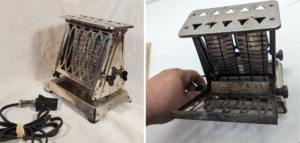Imagine a crisp Saturday morning in the 1950s, a time when families gathered and traditions were formed in the heart of the home: the kitchen. As the smell of freshly brewed coffee mixes with the cool morning air, you see a family member busy with a striking, shiny metal device. It is the stovetop toaster, an innovation that was considered a luxury at the time and played a central role in the morning ritual. The person at the stove carefully turns slices of bread, which slowly transform into perfect golden brown treats. This ritual was not just a method of preparing food; it was an art form that required patience and precision, making every breakfast a special occasion

Reflection
The stovetop toaster was an example of minimalism and… functionality, but its true impact was in the way it enriched everyday family life.
Unlike today’s pop-up toasters, using this appliance required direct contact with the stove, with the bread carefully placed on wire racks and cooked to perfect crispiness by the stove’s heat.
This action, although simple, involved an element of tension as one hoped that the bread would not burn.





